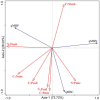Responses of soil microbial biomass, microbial entropy and soil-microorganism stoichiometry imbalance to different utilization patterns in the artificial grassland of karst desertification area
- PMID: 38075925
- PMCID: PMC10704894
- DOI: 10.3389/fmicb.2023.1293353
Responses of soil microbial biomass, microbial entropy and soil-microorganism stoichiometry imbalance to different utilization patterns in the artificial grassland of karst desertification area
Abstract
Different utilization patterns can alter the C, N, P cycles and their ecological stoichiometry characteristics in grassland soils. However, the effects of different utilization patterns on soil microbial biomass, microbial entropy and soil-microorganism stoichiometry imbalance of artificial grassland are not clear. So this study was took different utilization patterns of artificial grassland [i.e., grazing grassland (GG), mowing grassland (MG), enclosed grassland (EG)] as the research object to investigate responses of soil microbial biomass, microbial entropy and soil-microorganism stoichiometry imbalance to different utilization patterns in the karst rocky desertification control area. We found that the contents of microbial biomass carbon (MBC) and microbial biomass nitrogen (MBN) were highest in GG, and the content of microbial biomass phosphorus (MBP) was highest in EG. Soil microbial biomass entropy carbon (qMBC) and soil microbial biomass entropy nitrogen (qMBN) of GG and MG were higher than those of EG, but soil microbial biomass entropy phosphorus (qMBP) was opposite. C:N stoichiometry imbalance (C:Nimb) was EG > GG > MG, C:P stoichiometry imbalance (C:Pimb) was EG > MG > GG, N:P stoichiometry imbalance (N:Pimb) was MG > EG > GG. MBN was significantly positive correlated with C:Nimb and C:Pimb, MBC was significantly negative correlated with C:Pimb, MBP was significantly negative correlated with N:Pimb. The redundancy analysis (RDA) results showed that N:Pimb (p = 0.014), C:Nimb (p = 0.014), and C:P in the soil (C:Psoil, p = 0.028) had the most significant effect on microbial entropy. EG had a significant effect on soil microbial biomass and microbial entropy. The results of this study can directly or indirectly reflect the grassland soil quality under different utilization patterns in the karst rocky desertification area, which has a certain reference value for the degraded ecosystem restoration.
Keywords: artificial grassland; karst desertification; microbial entropy; soil microbial biomass; stoichiometry imbalance.
Copyright © 2023 Chi, Song, Xiong, Albasher and Fang.
Conflict of interest statement
The authors declare that the research was conducted in the absence of any commercial or financial relationships that could be construed as a potential conflict of interest.
Figures
References
-
- Anderson T. H. (2003). Microbial eco-physiological indicators to asses soil quality. Agric. Ecosyst. Environ. 98, 285–293. doi: 10.1016/S0167-8809(03)00088-4 - DOI
-
- Anderson T. H., Domsch K. H. (1990). Application of eco-physiological quotients (qCO2 and qD) on microbial biomasses from soils of different cropping histories. Soil Biol. Biochem. 22, 251–255. doi: 10.1016/0038-0717(90)90094-G - DOI
-
- Bao S. D. (2000). Soil and agricultural chemistry analysis. Beijing: China Agriculture Press.
Associated data
LinkOut - more resources
Full Text Sources
Miscellaneous



